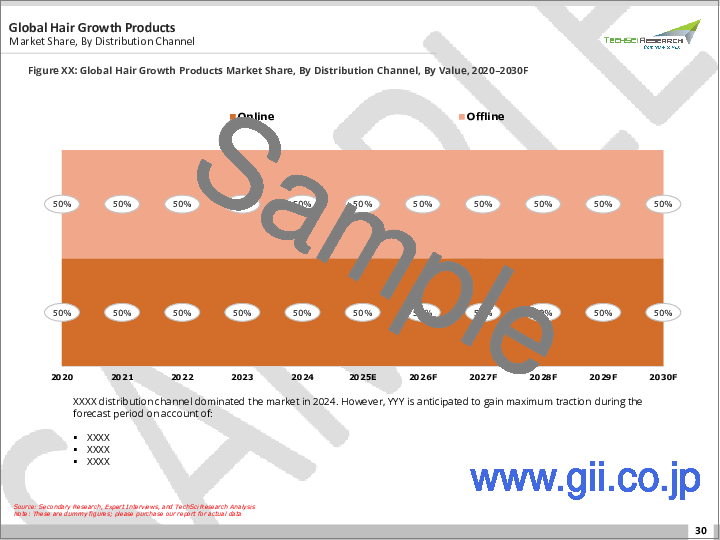|
|
市場調査レポート
商品コード
1807377
育毛製品市場- 世界の産業規模、シェア、動向、成長機会、予測、タイプ別、流通チャネル別、地域別、競合市場、2020-2030年Hair Growth Products Market - Global Industry Size, Share, Trends, Opportunity and Forecast, By Type, By Distribution Channel, By Region & Competition, 2020-2030F |
||||||
カスタマイズ可能
|
|||||||
| 育毛製品市場- 世界の産業規模、シェア、動向、成長機会、予測、タイプ別、流通チャネル別、地域別、競合市場、2020-2030年 |
|
出版日: 2025年08月31日
発行: TechSci Research
ページ情報: 英文 181 Pages
納期: 2~3営業日
|
全表示
- 概要
- 目次
育毛製品の世界市場規模は2024年に87億1,000万米ドルとなり、予測期間中のCAGRは3.20%で2030年には105億米ドルに成長すると予測されます。
世界の育毛製品市場は、すべての年齢層と性別で薄毛と脱毛の有病率が増加しているため、大きな成長を遂げています。ヘアケアに対する消費者の意識の高まりと、効果的で安全なソリューションへの嗜好の高まりが、美容液、オイル、シャンプー、サプリメントなどの専用製品への需要を促進しています。天然成分、オーガニック成分、臨床試験済み成分など、処方の革新が幅広い消費者層を引き付けています。さらに、ソーシャルメディア、美容動向、セレブリティの推薦の影響力が、市場導入をさらに促進しています。eコマース・プラットフォームはアクセシビリティを拡大し、世界中で便利な購入と製品の多様化を可能にしています。
| 市場概要 | |
|---|---|
| 予測期間 | 2026-2030 |
| 市場規模:2024年 | 87億1,000万米ドル |
| 市場規模:2030年 | 105億米ドル |
| CAGR:2025年~2030年 | 3.20% |
| 急成長セグメント | オンライン |
| 最大市場 | アジア太平洋 |
市場促進要因
抜け毛と薄毛の有病率の上昇
主な市場課題
最先端技術の高コスト育毛製品
主要市場動向
製品開発における先端技術の統合
目次
第1章 イントロダクション
第2章 調査手法
第3章 エグゼクティブサマリー
第4章 顧客の声
第5章 世界の育毛製品市場展望
- 市場規模・予測
- 金額別
- 市場シェア・予測
- タイプ別(シャンプー&コンディショナー、美容液、オイル、サプリメント&ビタミン、その他)
- 流通チャネル別(オンライン、オフライン)
- 地域別
- 企業別(2024)
- 市場マップ
第6章 北米の育毛製品市場展望
- 市場規模・予測
- 市場シェア・予測
- 北米:国別分析
- 米国
- カナダ
- メキシコ
第7章 欧州の育毛製品市場展望
- 市場規模・予測
- 市場シェア・予測
- 欧州:国別分析
- フランス
- ドイツ
- スペイン
- イタリア
- 英国
第8章 アジア太平洋地域の育毛製品市場展望
- 市場規模・予測
- 市場シェア・予測
- アジア太平洋地域:国別分析
- 中国
- 日本
- インド
- 韓国
- インドネシア
第9章 中東・アフリカの育毛製品市場展望
- 市場規模・予測
- 市場シェア・予測
- 中東・アフリカ:国別分析
- 南アフリカ
- サウジアラビア
- アラブ首長国連邦
- トルコ
第10章 南米の育毛製品市場展望
- 市場規模・予測
- 市場シェア・予測
- 南米:国別分析
- ブラジル
- アルゼンチン
- コロンビア
第11章 市場力学
- 促進要因
- 課題
第12章 市場動向と発展
- 合併と買収
- 製品上市
- 最近の動向
第13章 混乱:紛争、パンデミック、貿易障壁
第14章 ポーターのファイブフォース分析
- 業界内の競合
- 新規参入の可能性
- サプライヤーの力
- 顧客の力
- 代替品の脅威
第15章 競合情勢
- 企業プロファイル
- Unilever PLC
- L'Oreal SA
- Johnson & Johnson Services, Inc.
- The Procter & Gamble Company
- Meda Pharmaceuticals Pty Ltd
- AminoGenesis Pty Ltd
- Viviscal Limited
- Wella Company International Operations Switzerland S.a.r.l.(Nioxins)
- Kao Corporation
- Shiseido Company, Limited
第16章 戦略的提言
第17章 調査会社について・免責事項
Global Hair Growth Products Market was valued at USD 8.71 billion in 2024 and is expected to grow to USD 10.50 billion by 2030 with a CAGR of 3.20% during the forecast period. The global hair growth products market is witnessing significant growth due to increasing prevalence of hair thinning and hair loss across all age groups and genders. Rising consumer awareness about hair care, coupled with a growing preference for effective and safe solutions, is fueling demand for specialized products such as serums, oils, shampoos, and supplements. Innovations in formulations, including natural, organic, and clinically tested ingredients, are attracting a broader consumer base. Additionally, the influence of social media, beauty trends, and celebrity endorsements is further driving market adoption. E-commerce platforms are expanding accessibility, enabling convenient purchase and product variety worldwide.
| Market Overview | |
|---|---|
| Forecast Period | 2026-2030 |
| Market Size 2024 | USD 8.71 Billion |
| Market Size 2030 | USD 10.50 Billion |
| CAGR 2025-2030 | 3.20% |
| Fastest Growing Segment | Online |
| Largest Market | Asia Pacific |
Key Market Drivers
Rising Prevalence of Hair Loss and Hair Thinning
A major driver of the global hair growth products market is the increasing incidence of hair loss and thinning among consumers worldwide. Medically referred to as alopecia, this condition impacts millions across all ages and genders. Contributing factors include genetics, hormonal fluctuations, stress, poor diet, and environmental pollution. Since hair is closely linked to personal appearance and self-confidence, individuals are actively seeking effective solutions to prevent hair loss and encourage regrowth. This rising demand has prompted manufacturers to innovate products such as serums, shampoos, conditioners, oils, and dietary supplements that target thinning hair and scalp health.
Reports indicate that around 7 million people in the U.S. and 160 million globally either currently have, have had, or are expected to develop alopecia areata, with approximately 700,000 individuals in the U.S. currently affected. Furthermore, the aging population is increasingly prone to hair loss due to hormonal changes, driving further adoption of hair growth solutions. Consequently, the market continues to experience steady growth, as consumers show a strong willingness to invest in products that deliver visible and lasting results.
Key Market Challenges
High Cost of Advanced Hair Growth Products
One of the primary challenges in the global hair growth products market is the relatively high cost of advanced and clinically proven solutions. Products containing premium ingredients, biotechnology-driven formulations, or proprietary blends often come with a significant price tag. This can deter price-sensitive consumers, particularly in emerging markets, where affordability plays a critical role in purchasing decisions. Additionally, ongoing treatment regimens, which may span several months to achieve visible results, further increase the overall expense for users. The high cost also limits adoption among younger consumers or those experiencing mild hair thinning who may prefer cheaper, conventional alternatives. Consequently, while technological innovations enhance efficacy, they can also restrict market penetration in regions with lower disposable incomes, posing a challenge for manufacturers seeking global expansion.
Key Market Trends
Integration of Advanced Technologies in Product Development
Technological innovation is increasingly influencing the hair growth market. Companies are leveraging biotechnology, nanotechnology, and artificial intelligence (AI) to create more effective and personalized hair growth solutions. Nanotechnology, for instance, enhances the delivery of active ingredients directly to hair follicles, improving absorption and efficacy. AI-driven diagnostic tools allow for customized treatments based on individual scalp conditions, hair type, and growth patterns. In the realm of AI, a study published in Dermatology Times in May 2025 highlighted that an AI-driven platform for customizing hair loss treatments significantly improved hair growth, scalp health, and hair texture in a 24-week study involving women with self-reported hair thinning
Additionally, research innovations are enabling the development of novel formulations with enhanced potency, such as peptide-based serums or hormone-regulating treatments. These advancements not only improve product performance but also reinforce consumer trust by offering clinically validated and science-backed solutions.
Key Market Players
- Unilever PLC
- L'Oreal SA
- Johnson & Johnson Services, Inc.
- The Procter & Gamble Company
- Meda Pharmaceuticals Pty Ltd
- AminoGenesis Pty Ltd
- Viviscal Limited
- Wella Company International Operations Switzerland S.a.r.l. (Nioxins)
- Kao Corporation
- Shiseido Company, Limited
Report Scope:
In this report, the Global Hair Growth Products Market has been segmented into the following categories, in addition to the industry trends which have also been detailed below:
Hair Growth Products Market, By Type:
- Shampoos & Conditioners
- Serums
- Oils
- Supplements and Vitamins
- Others
Hair Growth Products Market, By Distribution Channel:
- Online
- Offline
Hair Growth Products Market, By Region:
- North America
- United States
- Canada
- Mexico
- Europe
- France
- United Kingdom
- Italy
- Germany
- Spain
- Asia-Pacific
- China
- Japan
- India
- South Korea
- Indonesia
- South America
- Argentina
- Colombia
- Brazil
- Middle East & Africa
- South Africa
- Saudi Arabia
- UAE
- Turkey
Competitive Landscape
Company Profiles: Detailed analysis of the major companies presents in the Global Hair Growth Products Market.
Available Customizations:
Global Hair Growth Products Market report with the given market data, TechSci Research offers customizations according to a company's specific needs. The following customization options are available for the report:
Company Information
- Detailed analysis and profiling of additional market players (up to five).
Table of Contents
1. Introduction
- 1.1. Product Overview
- 1.2. Key Highlights of the Report
- 1.3. Market Coverage
- 1.4. Market Segments Covered
- 1.5. Research Tenure Considered
2. Research Methodology
- 2.1. Methodology Landscape
- 2.2. Objective of the Study
- 2.3. Baseline Methodology
- 2.4. Formulation of the Scope
- 2.5. Assumptions and Limitations
- 2.6. Sources of Research
- 2.7. Approach for the Market Study
- 2.8. Methodology Followed for Calculation of Market Size & Market Shares
- 2.9. Forecasting Methodology
3. Executive Summary
- 3.1. Overview of the Market
- 3.2. Overview of Key Market Segmentations
- 3.3. Overview of Key Market Players
- 3.4. Overview of Key Regions
- 3.5. Overview of Market Drivers, Challenges, and Trends
4. Voice of Customer
- 4.1. Brand Awareness
- 4.2. Factors Influence Purchase Decision
5. Global Hair Growth Products Market Outlook
- 5.1. Market Size & Forecast
- 5.1.1. By Value
- 5.2. Market Share & Forecast
- 5.2.1. By Type (Shampoos & Conditioners, Serums, Oils, Supplements and Vitamins, Others)
- 5.2.2. By Distribution Channel (Online, Offline)
- 5.2.3. By Region
- 5.2.4. By Company (2024)
- 5.3. Market Map
6. North America Hair Growth Products Market Outlook
- 6.1. Market Size & Forecast
- 6.1.1. By Value
- 6.2. Market Share & Forecast
- 6.2.1. By Type
- 6.2.2. By Distribution Channel
- 6.2.3. By Country
- 6.3. North America: Country Analysis
- 6.3.1. United States Hair Growth Products Market Outlook
- 6.3.1.1. Market Size & Forecast
- 6.3.1.1.1. By Value
- 6.3.1.2. Market Share & Forecast
- 6.3.1.2.1. By Type
- 6.3.1.2.2. By Distribution Channel
- 6.3.1.1. Market Size & Forecast
- 6.3.2. Canada Hair Growth Products Market Outlook
- 6.3.2.1. Market Size & Forecast
- 6.3.2.1.1. By Value
- 6.3.2.2. Market Share & Forecast
- 6.3.2.2.1. By Type
- 6.3.2.2.2. By Distribution Channel
- 6.3.2.1. Market Size & Forecast
- 6.3.3. Mexico Hair Growth Products Market Outlook
- 6.3.3.1. Market Size & Forecast
- 6.3.3.1.1. By Value
- 6.3.3.2. Market Share & Forecast
- 6.3.3.2.1. By Type
- 6.3.3.2.2. By Distribution Channel
- 6.3.3.1. Market Size & Forecast
- 6.3.1. United States Hair Growth Products Market Outlook
7. Europe Hair Growth Products Market Outlook
- 7.1. Market Size & Forecast
- 7.1.1. By Value
- 7.2. Market Share & Forecast
- 7.2.1. By Type
- 7.2.2. By Distribution Channel
- 7.2.3. By Country
- 7.3. Europe: Country Analysis
- 7.3.1. France Hair Growth Products Market Outlook
- 7.3.1.1. Market Size & Forecast
- 7.3.1.1.1. By Value
- 7.3.1.2. Market Share & Forecast
- 7.3.1.2.1. By Type
- 7.3.1.2.2. By Distribution Channel
- 7.3.1.1. Market Size & Forecast
- 7.3.2. Germany Hair Growth Products Market Outlook
- 7.3.2.1. Market Size & Forecast
- 7.3.2.1.1. By Value
- 7.3.2.2. Market Share & Forecast
- 7.3.2.2.1. By Type
- 7.3.2.2.2. By Distribution Channel
- 7.3.2.1. Market Size & Forecast
- 7.3.3. Spain Hair Growth Products Market Outlook
- 7.3.3.1. Market Size & Forecast
- 7.3.3.1.1. By Value
- 7.3.3.2. Market Share & Forecast
- 7.3.3.2.1. By Type
- 7.3.3.2.2. By Distribution Channel
- 7.3.3.1. Market Size & Forecast
- 7.3.4. Italy Hair Growth Products Market Outlook
- 7.3.4.1. Market Size & Forecast
- 7.3.4.1.1. By Value
- 7.3.4.2. Market Share & Forecast
- 7.3.4.2.1. By Type
- 7.3.4.2.2. By Distribution Channel
- 7.3.4.1. Market Size & Forecast
- 7.3.5. United Kingdom Hair Growth Products Market Outlook
- 7.3.5.1. Market Size & Forecast
- 7.3.5.1.1. By Value
- 7.3.5.2. Market Share & Forecast
- 7.3.5.2.1. By Type
- 7.3.5.2.2. By Distribution Channel
- 7.3.5.1. Market Size & Forecast
- 7.3.1. France Hair Growth Products Market Outlook
8. Asia-Pacific Hair Growth Products Market Outlook
- 8.1. Market Size & Forecast
- 8.1.1. By Value
- 8.2. Market Share & Forecast
- 8.2.1. By Type
- 8.2.2. By Distribution Channel
- 8.2.3. By Country
- 8.3. Asia-Pacific: Country Analysis
- 8.3.1. China Hair Growth Products Market Outlook
- 8.3.1.1. Market Size & Forecast
- 8.3.1.1.1. By Value
- 8.3.1.2. Market Share & Forecast
- 8.3.1.2.1. By Type
- 8.3.1.2.2. By Distribution Channel
- 8.3.1.1. Market Size & Forecast
- 8.3.2.Japan Hair Growth Products Market Outlook
- 8.3.2.1. Market Size & Forecast
- 8.3.2.1.1. By Value
- 8.3.2.2. Market Share & Forecast
- 8.3.2.2.1. By Type
- 8.3.2.2.2. By Distribution Channel
- 8.3.2.1. Market Size & Forecast
- 8.3.3. India Hair Growth Products Market Outlook
- 8.3.3.1. Market Size & Forecast
- 8.3.3.1.1. By Value
- 8.3.3.2. Market Share & Forecast
- 8.3.3.2.1. By Type
- 8.3.3.2.2. By Distribution Channel
- 8.3.3.1. Market Size & Forecast
- 8.3.4. South Korea Hair Growth Products Market Outlook
- 8.3.4.1. Market Size & Forecast
- 8.3.4.1.1. By Value
- 8.3.4.2. Market Share & Forecast
- 8.3.4.2.1. By Type
- 8.3.4.2.2. By Distribution Channel
- 8.3.4.1. Market Size & Forecast
- 8.3.5. Indonesia Hair Growth Products Market Outlook
- 8.3.5.1. Market Size & Forecast
- 8.3.5.1.1. By Value
- 8.3.5.2. Market Share & Forecast
- 8.3.5.2.1. By Type
- 8.3.5.2.2. By Distribution Channel
- 8.3.5.1. Market Size & Forecast
- 8.3.1. China Hair Growth Products Market Outlook
9. Middle East & Africa Hair Growth Products Market Outlook
- 9.1. Market Size & Forecast
- 9.1.1. By Value
- 9.2. Market Share & Forecast
- 9.2.1. By Type
- 9.2.2. By Distribution Channel
- 9.2.3. By Country
- 9.3. MEA: Country Analysis
- 9.3.1. South Africa Hair Growth Products Market Outlook
- 9.3.1.1. Market Size & Forecast
- 9.3.1.1.1. By Value
- 9.3.1.2. Market Share & Forecast
- 9.3.1.2.1. By Type
- 9.3.1.2.2. By Distribution Channel
- 9.3.1.1. Market Size & Forecast
- 9.3.2. Saudi Arabia Hair Growth Products Market Outlook
- 9.3.2.1. Market Size & Forecast
- 9.3.2.1.1. By Value
- 9.3.2.2. Market Share & Forecast
- 9.3.2.2.1. By Type
- 9.3.2.2.2. By Distribution Channel
- 9.3.2.1. Market Size & Forecast
- 9.3.3. UAE Hair Growth Products Market Outlook
- 9.3.3.1. Market Size & Forecast
- 9.3.3.1.1. By Value
- 9.3.3.2. Market Share & Forecast
- 9.3.3.2.1. By Type
- 9.3.3.2.2. By Distribution Channel
- 9.3.3.1. Market Size & Forecast
- 9.3.4. Turkey Hair Growth Products Market Outlook
- 9.3.4.1. Market Size & Forecast
- 9.3.4.1.1. By Value
- 9.3.4.2. Market Share & Forecast
- 9.3.4.2.1. By Type
- 9.3.4.2.2. By Distribution Channel
- 9.3.4.1. Market Size & Forecast
- 9.3.1. South Africa Hair Growth Products Market Outlook
10. South America Hair Growth Products Market Outlook
- 10.1. Market Size & Forecast
- 10.1.1. By Value
- 10.2. Market Share & Forecast
- 10.2.1. By Type
- 10.2.2. By Distribution Channel
- 10.2.3. By Country
- 10.3. South America: Country Analysis
- 10.3.1. Brazil Hair Growth Products Market Outlook
- 10.3.1.1. Market Size & Forecast
- 10.3.1.1.1. By Value
- 10.3.1.2. Market Share & Forecast
- 10.3.1.2.1. By Type
- 10.3.1.2.2. By Distribution Channel
- 10.3.1.1. Market Size & Forecast
- 10.3.2. Argentina Hair Growth Products Market Outlook
- 10.3.2.1. Market Size & Forecast
- 10.3.2.1.1. By Value
- 10.3.2.2. Market Share & Forecast
- 10.3.2.2.1. By Type
- 10.3.2.2.2. By Distribution Channel
- 10.3.2.1. Market Size & Forecast
- 10.3.3. Colombia Hair Growth Products Market Outlook
- 10.3.3.1. Market Size & Forecast
- 10.3.3.1.1. By Value
- 10.3.3.2. Market Share & Forecast
- 10.3.3.2.1. By Type
- 10.3.3.2.2. By Distribution Channel
- 10.3.3.1. Market Size & Forecast
- 10.3.1. Brazil Hair Growth Products Market Outlook
11. Market Dynamics
- 11.1. Drivers
- 11.2. Challenges
12. Market Trends & Developments
- 12.1. Merger & Acquisition (If Any)
- 12.2. Product Launches (If Any)
- 12.3. Recent Developments
13. Disruptions: Conflicts, Pandemics and Trade Barriers
14. Porters Five Forces Analysis
- 14.1. Competition in the Industry
- 14.2. Potential of New Entrants
- 14.3. Power of Suppliers
- 14.4. Power of Customers
- 14.5. Threat of Substitute Products
15. Competitive Landscape
- 15.1. Company Profiles
- 15.1.1. Unilever PLC
- 15.1.1.1. Business Overview
- 15.1.1.2. Company Snapshot
- 15.1.1.3. Products & Services
- 15.1.1.4. Financials (As Per Availability)
- 15.1.1.5. Key Market Focus & Geographical Presence
- 15.1.1.6. Recent Developments
- 15.1.1.7. Key Management Personnel
- 15.1.2. L'Oreal SA
- 15.1.3. Johnson & Johnson Services, Inc.
- 15.1.4. The Procter & Gamble Company
- 15.1.5. Meda Pharmaceuticals Pty Ltd
- 15.1.6. AminoGenesis Pty Ltd
- 15.1.7. Viviscal Limited
- 15.1.8. Wella Company International Operations Switzerland S.a.r.l. (Nioxins)
- 15.1.9. Kao Corporation
- 15.1.10. Shiseido Company, Limited
- 15.1.1. Unilever PLC




